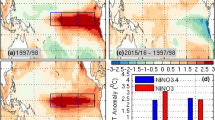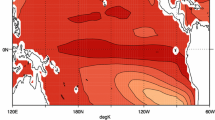Abstract
A general circulation model is used to simulate the atmospheric response to a prescribed, idealized time varying warm sea surface temperature anomaly (SSTA) in the equatorial Pacific characteristic of ENSO events. The model incorporates the full seasonal cycle and an ensemble of five anomaly simulations, each of 14 months duration, is performed and the results compared with those from a ten year control simulation involving climatological SSTs. In a test of the model, simulated perturbations to precipitation patterns are compared with the analysis by Ropelewski and Halpert which identifies regions where precipitation perturbations are associated with the ENSO cycle. Strong and statistically significant perturbations are simulated throughout much of the equatorial Pacific and the Australian region which agree with the analysis. Perturbations over the Americas and the Indian sub-continent show part agreement with observations, while elsewhere, at more remote and high latitude locations, there is less agreement, providing some indication of model limitations in simulating the hydrological cycle. Over the equatorial Pacific most of the anomalous precipitation is accounted for by moisture flux convergence. Only in the vicinity of the maximum anomaly, located in the eastern Pacific, do warmer SSTs contribute to the perturbed circulation. Elsewhere, anomalous wind speeds mainly determine anomalous heat fluxes. As a result, the large scale perturbations to wind, moisture and precipitation appear to be forced indirectly, rather than directly as assumed in simple ocean-atmosphere models.
Similar content being viewed by others
References
Alexander RC, Mobley RL (1976) Monthly average sea-surface temperatures and ice-pack limits on a 1° global grid. Mon Wea Rev 107:896–910
Chervin RM, Schneider SH (1976) On determining the statistical significance of climate experiments with general circulation models. J Atmos Sci 33:405–412
Deser C, Wallace JM (1990) Large-scale atmospheric circulation features of warm and cold episodes in the tropical Pacific. J Clim 3:1254–1281
Fennessy MJ, Shukla J (1988) Numerical simulation of the atmospheric response to the time-varying El Nino SST anomalies during May 1982 through October 1983. J Clim 1:195–211
Fennessy MJ, Shukla J (1989) Impact of the 1982–83 and 1986–87 Pacific SST anomalies on the time mean prediction with the GLAS GCM. In: Modelling the sensitivity and variations of the ocean-atmosphere system. Report of a workshop at the European Centre for medium-range weather forecasts. WMO/ TD-No.254, WCRP-15, World Meteorological Organization, Geneva, Switzerland
Fu C, Diaz HF, Fletcher JO (1986) Characteristics of the response of sea surface temperature in the central Pacific associated with warm episodes of the Southern Oscillation. Mon. Wea Rev 114:1716–1738
Gordon HB (1981) A flux formulation of the spectral atmospheric equations suitable for use in long term climate modelling. Mon Wea Rev 109:56–64
Gordon HB, Hunt BG (1990) Droughts, floods and sea surface temperature anomalies: a modelling approach. Int J Clim 11:347–365
Graham NE, Barnett TP (1987) Sea surface temperature, surface wind divergence, and convection over tropical oceans. Science 238:657–659
Gunn WG, McBride JL, Holland GJ, Keenan TD, Davidson NE, Hendon HH (1989) The Australian summer monsoon circulation during AMEX phase II. Mon Wea Rev 117:2554–2534
Hunt BG, Gordon HB (1989) Diurnally varying regional climatic simulations. Int J Clim 9:331–356
Julian PR, Chervin RM (1978) A study of the Southern Oscillation and the Walker circulation phenomenon. Mon Wea Rev 106:1433–1451
Kang I-S, Lau N-C (1986) Principal modes of atmospheric variability in model atmospheres with and without anomalous sea surface temperature forcing in the tropical Pacific. J Atmos Sci 43:2719–2735
Kang I-S (1988) Interannual variability of winter mean precipitation and upper-level circulation in extended GCM integrations with and without interannual variation of tropical Pacific SST. J Meteor Japan 66:741–751
Kang I-S, Ho C, Kim SS (1987) Interannual and intraseasonal variations of summer precipitation simulated by a GCM and the influence of tropical Pacific SST on the interannual variability. J Korean Met Soc 23–3:12–24
Keshavamurty RN (1982) Response of the atmosphere to sea surface temperature anomalies over the equatorial Pacific and the teleconnections of the Southern Oscillation. J Atmos Sci 39:1241–1259
Khalsa SJS (1983) The role of sea surface temperature in large-scale air-sea interaction. Mon Wea Rev 111:954–966
Lau N-C (1985) Modeling the seasonal dependence of the atmospheric response to observed El Ninos in 1962–76. Mon Wea Rev 113:1970–1996
Lindzen RS, Nigam S (1987) On the role of sea surface temperature gradients in forcing low-level winds and convergence in the tropics. J Atmos Sci 44:2418–2436
Lorenz EN (1977) An experiment in non-linear statistical weather forecasting. Mon Wea Rev 105:590–602
Mechoso CR, Kitoh A, Moorthi S, Arakawa A (1987) Numerical simulations of the atmospheric response to sea surface temperature anomaly over the equatorial eastern Pacific ocean. Mon Wea Rev 115:2936–2956
Nicholls N (1985) Towards the prediction of major Australian droughts. Aust Met Mag 33:161–166
Pan YH, Oort AH (1983) Global climate variations connected with sea-surface temperature anomalies in the eastern equatorial Pacific ocean for the 1958–73 period. Mon Wea Rev 111:1244–1258
Quiroz RS (1983) The climate of the “El Nino” winter of 198283-a season of extraordinary climatic anomalies. Mon Wea Rev 111:1685–1706
Rasmusson EM, Carpenter TH (1982) Variations in tropical sea surface temperature and surface wind fields associated with the Southern Oscillation/El Nino. Mon Wea Rev 110:354–384
Rasmusson EM, Carpenter TH (1983) The relationship between eastern equatorial Pacific sea surface temperatures and rainfall over India and Sri Lanka. Mon Wea Rev 111:517–528
Ropelewski CF, Halpert MS (1987) Global and regional scale precipitation patterns associated with the El Nino/Southern Oscillation. Mon Wea Rev 115:1606–1626
Shukla J, Wallace JM (1983) Numerical simulation of the atmospheric response to equatorial Pacific sea surface temperature anomalies. J Atmos Sci 40:1613–1630
Simmonds I (1990) A modelling study of winter circulation and precipitation anomalies associated with Australian region ocean temperatures. Aus Met Mag 38:151–162
Simmonds I, Smith IN (1986) The effect of the prescription of zonally-uniform sea surface temperatures in a general circulation model. J Clim 6:641–659
Simmonds I, Dix M, Rayner P, Trigg G (1989) Local and remote response to zonally uniform sea-surface temperature in a July general circulation model. Int J Clim 9:111–131
Voice ME, Hunt BG (1984) A study of the dynamics of drought initiation using a global general circulation model. J Geophys Res 89:9504–9520
Ward MN, Folland CK, Maskell K, Owen JA, Bottomley M (1990) Forecasting Sahel rainfall — an update. Weather 45:122–125
Weare BC (1987) Relationships between monthly precipitation and SST variations in the tropical Pacific. Mon Wea Rev 115:2687–2698
Webster PJ (1982) Seasonality in the local and remote atmospheric response to sea surface temperature anomalies J Atmos Sci 39:41–52
Whetton PH, Pittock AB (1991) Australian region intercomparison of the results of some general circulation models used in enhanced greenhouse experiments. CSIRO DAR Technical Paper No. 21
Author information
Authors and Affiliations
Rights and permissions
About this article
Cite this article
Smith, I.N., Gordon, H.B. Simulations of precipitation and atmospheric circulation changes associated with warm SSTs: results from an ensemble of long term integrations with idealized anomalies. Climate Dynamics 7, 141–153 (1992). https://doi.org/10.1007/BF00211156
Received:
Accepted:
Issue Date:
DOI: https://doi.org/10.1007/BF00211156




